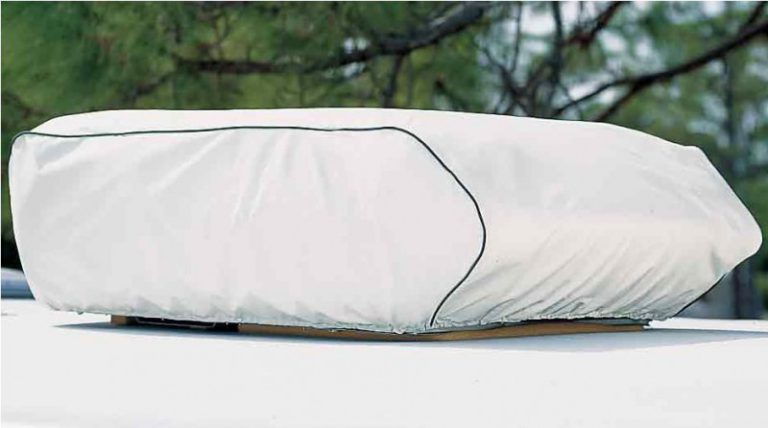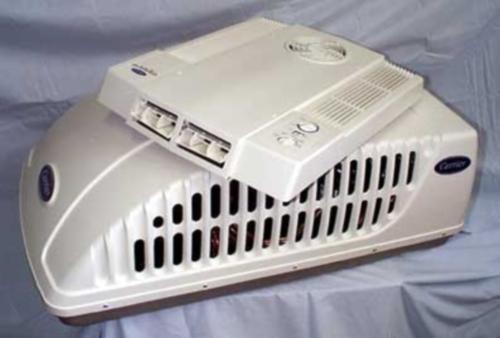
An RV is by its very nature a massive vehicle that requires more than its fair share of maintenance. Sometimes on such a big vehicle, it’s the little parts that can cause the most headaches.
In this case, I’m referencing the air conditioner, which will often need new parts or materials to protect it and prevent it from expiring before its time.
RV Air Conditioner Cover
The RV air conditioner cover is a fabric cases that ties around the rooftop shroud of the AC unit when the vehicle or the unit isn’t in use. Generally, they’re made from vinyl and reinforced with weatherproof nylon thread and a parachute drawstring at the base to keep the case tight around the air conditioner.
RV air conditioner covers are usually one-size-fits-all, as the parachute drawstring is meant to be secure around the unit, no matter how short or tall its profile. If you have a shroud with a particularly high or low profile, you may want to look for a larger or smaller cover for a more suitable fit.
Covers are generally cheap, rarely exceeding $25 in price. CampingWorld currently offers a model under $10 on sale.
Generator & Air Conditioner Capacitor
If you plan on using your air conditioner often while the RV is parked without leeching off the vehicle’s fuel or battery, you may want to buy a separate generator to accommodate for the power it uses. There are dozens of suitable generators for sale, but you must consider your RV air conditioner amps — how much power it draws, in other words. On average, a standard 13,500 btu unit draws 11.5 amps, which means it can run off a standard small-sized generator with some exceptions. It may have trouble upon start-up and occasionally power down due to lack of current.
This happens primarily in hot and humid conditions, when the AC compressor requires so much current to start it may overload your generator or generators. For instances like these, you’ll want to purchase an RV air conditioner capacitor. Some units may come with the hard-start capacitor kit you need, but for others, you’ll need to purchase it from retailers who normally sell such pieces for anywhere from $10 to $30. Most, if not all, AC units work with a hard-start capacitor, and your schematic should detail where it can be attached.
The capacitor comes with electrolytic capacitor, a PTCR (positive temperature coefficent resistor) device and hook-up wires. Installation is relatively easy. Make sure the power is disconnected before beginning the process. LoveYourRV.com describes how to do it, once you’re on the roof and removed the air conditioner’s shroud:
On the driver’s side of the AC, there is a small access panel with a few screws. Once you get that off you will see a bunch of colored wires and some capacitors. On the inside of the access panel, you should find a schematic, look for the run capacitor. That is the capacitor the hard start capacitor will connect to. The wire on the hard start capacitor connected to the PTCR goes to the same connector as the red wire and the other wire goes to the yellow one.
The connectors should just clip on to some extra lugs on the run capacitor. After you get the electrical connection completed then all that is left is to mount the hard start capacitor.
This should solve any issues you’ve had with the air conditioner’s compressor drawing enough current upon startup.
Air Conditioner Filters
You will likely have to purchase an RV air conditioner filter or filters at some point to keep your unit running clean without issue. These stop dirt and other unwanted elements from going through your air conditioner and into your RV, but they inevitably, of course, get dirty.
A dirty filter reduces the efficiency of your air conditioner. Many are washable and reusable, though they tend to deteriorate after several washes. Make sure the filter is completely dry after washing before replacing it. You should check and wash the filters roughly once a month. If it needs to be replaced, you can find more filters for $30 or less, designed for specific models or made for universal usage.
Heat Pump
Those who want to get the most out of their AC unit no matter what the season should consider purchasing an RV air conditioner heat pump. Models like the Coleman HP2 will heat as well as cool, thanks to a unique reversing valve that converts the cooling powers into an efficient and powerful heating system. Unfortunately, these heat pumps must be bought as a full unit, rather than as add-ons. Therefore, the units are uniformly expensive, generally exceeding $600 in price.
There’s a lot to keep track of with something as small as an RV air conditioner, but once you’ve gotten the hang of its maintenance, you’ll understand the value of having a properly equipped air conditioner when facing the scorching heats in warm summer climates.





